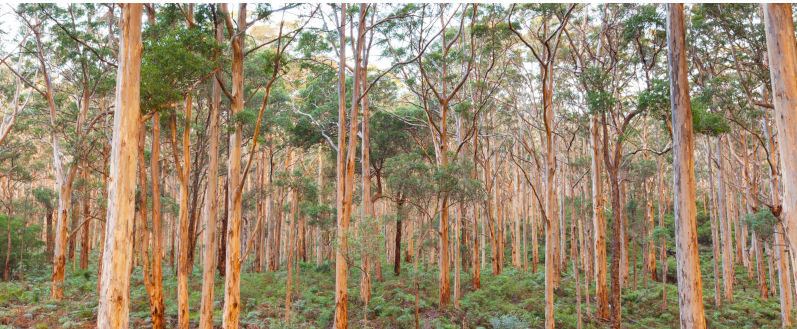The Federal Opposition’s energy policy includes the construction of nuclear power plants. Peter Dutton says that we need them because Australia’s emissions reduction target of 43 per cent on 2005 levels by 2030 is unachievable. Is this true? We argue that it is not – and especially if the Australian Government works with State and Territory Governments to stop native forest logging and land clearing.
Ending land clearing and halting logging of native forests would achieve a reduction of between 21.5 million and 37.5 million tonnes carbon dioxide equivalent a year. The reason for the wide range in values is because there is little public data available on emissions from logging. The minimum amount is the emissions from deforestation as reported in the Australian Government’s 2022 national GHG inventory report plus a conservative estimate of emissions from native forest logging, while the maximum includes logging emissions based on estimates from native forest log production presented in the national report plus supporting evidence from additional sources. The critical point being that this range is 25-44% of the 85.2 million tonnes of carbon dioxide equivalent that needs to be reduced annually for Australia to meet its 2030 target. A major reduction in emissions from logging and clearing forests would sit admirably along with Australia’s efforts to transition from fossil fuels to clean energy – which is now 40% of the electricity market (up from 15% a decade ago). Combined, these transitions will produce a more sustainable society within our environment.
This is an entirely feasible proposition, as ending native forest logging will serve to further stimulate investment in the plantation sector – where there are the most jobs and the best profits in the forest industry. Indeed, approximately 90% of all sawn timber in Australia (to make roof trusses, floorboards and furniture) already comes from plantations (ABARES 2021). Native forest logging generates predominantly woodchips, paper pulp and packaging (and not high-quality timber products). Plantations employ, on average, 3 times more people per ha of trees than do native forests. In addition, the capital investment needed for 1 full-time equivalent position in a native forest logging operation is almost ten times that needed for a full-time equivalent in a plantation because of capital investment requirements.
Native forest logging is a major financial loss maker everywhere it occurs. It continues only because of subsidies from governments. Financial losses and government handouts have exceeded well over a billion dollars in Tasmania and Victoria. Economic analyses have repeatedly shown that the economies of all States would be better off without a native forest logging sector. Despite the huge amounts of taxpayer funds “invested” in the native forest logging industry, it employs remarkably few people – people whom could readily be employed in other sectors (such as in plantation logging and plantation wood processing, forest restoration, control of weeds and pests, fire suppression, recreation infrastructure).
The co-benefits of ending land clearing and native of forest logging extend to our biodiversity. Australia has an appalling record on biodiversity loss; the nation leads the world in mammal extinctions and our threatened species list grows ever year. Logging and land clearing are preventable threats that have serious negative effects on biodiversity. For example, almost all areas proposed for logging support large numbers of threatened species – on average eight species in timber production forests in Victoria and similar numbers in New South Wales. Stopping logging and land clearing will dramatically improve the chances of persistence of many unique Australian species.
Policies to stop land clearing and native forest logging need to be rigorous. If not, they will otherwise be gamed. The Victorian Government, for example, has stated that it stopped native forest logging in January 2024. But in fact, it is implementing a plan to cut down millions of trees by constructing thousands of kilometres of 40+ metre wide firebreaks across the State over the next five years. This could result in an increase in the amount of forest being cut before native forest logging was supposedly halted. In fact, the firebreaks will be deforestation because the forest that is cut down will not be regenerated. The logs from this land clearing will be sold to firewood yards and sawmills. The potential increase in the amount of logging as a result of the expanded firebreaks would result in significant emissions from this kind of land clearing will make it harder to meet Australia’s national emissions reduction target, and the even stricter Victoria Government’s target. When native forest logging was taking place under VicForests, the Victoria Government estimated that it resulted in emissions equivalent to 730 000 motor vehicles every year.
If Australia stops native forest logging and land clearing it will have achieved between 25-44% of its 2030 emissions reduction target. Other key benefits will include ending the subsidies that State Governments need to pay to prop up native forest logging, reducing fire risks that are significantly increased by native forest logging, and slowing losses of biodiversity that results from logging and land clearing. Native forest logging stopped in South Australia 150 years ago and 45 years ago in the ACT. Victoria and Western Australia announced an end to native forest logging in January 2024. New South Wales, Queensland and Tasmania would be wise to follow suite. Ending land clearing remains a challenge in all states, and urgently requires tightening of existing regulations.
Article updated 12 November 2024.


